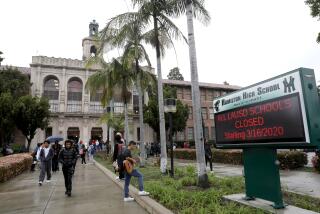What’s driving L.A. Unified’s better test scores?
Los Angeles schools showed the second-highest improvement in the nation on a test of urban school districts that is widely considered one of the most reliable measurements of student skills. This is cause for applause but also some frustration, because even the experts don’t know which factors are driving the improvement. The long-term success of students here and across the country depends on finding out.
The Trial Urban District Assessment uses the biannual test that’s familiarly called the nation’s report card, or more formally the National Assessment of Educational Progress. The program oversamples fourth- and eighth-grade students in participating school districts in order to get valid results for them.
L.A. Unified’s scores have been rising slowly since the urban district assessment began a decade ago, but figures released this week showed a more significant jump. Among L.A.’s fourth-graders, for example, the percentage of math students scoring at the bottom level — known as “below basic” — fell from 37% to 31%.
YEAR IN REVIEW: 12 political photos that made us look twice in 2013
None of this makes L.A. Unified a high-achieving district. Only 25% of its fourth-graders tested at proficient or advanced levels in math, and only 18% in reading. Still, improved scores indicate that something has been going right. The question is, what?
Researchers say it’s impossible to ferret out the reasons because the implementation of school reforms tends be haphazard, overly broad and seldom assessed. The higher scores seem to indicate, as reformers have claimed, that smaller class sizes don’t necessarily matter much; class sizes increased during the last few years because of the state’s budget crisis even as the test scores went up. At the same time, scores rose without the change sought by Supt. John Deasy and other reformers that would tie teachers’ performance ratings to their students’ test scores. Apparently, teachers are successfully improving scores without that kind of pressure.
The higher test scores might reflect policies from years ago that are only now starting to show results. Or some factors might not even be related to changes at schools at all, said UC Berkeley education professor Bruce Fuller. Education levels among Latina mothers have been rising, and maternal education has long been considered an important factor in early literacy.
With hundreds of millions of dollars coming to L.A. Unified from an improved state budget and a new school funding formula, it’s more important than ever for the district to use the money in targeted ways that can be measured and then copied if they’re successful. Future progress depends on knowing what works.
More to Read
A cure for the common opinion
Get thought-provoking perspectives with our weekly newsletter.
You may occasionally receive promotional content from the Los Angeles Times.










